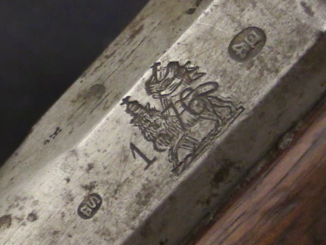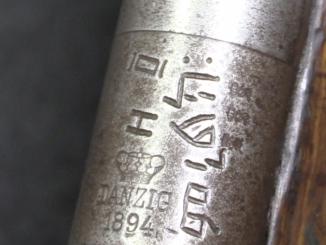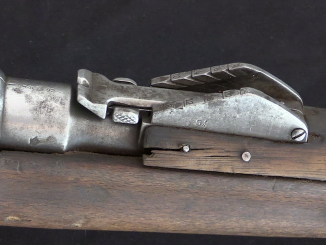Century International Arms has imported a quantity of Ethiopian ammunition, and asked me to do a video on it. So, I have a three-part evaluation here: appearance and packaging, live fire testing (including velocity and consistency), and teardown and bullet weight consistency. This ammunition was produced (as best I can tell) at the Emperor Haile Selassie Ammunition Factory, established with Czech technical aid in the late 1940s in Addis Ababa. This ammunition is all headstamped 1955, made for a variety of rifles and machine guns including the ZH-29, ZB-26, and FN BAR.
Velocity:
I tested velocity using a 7.92x57mm Yugoslav reworked K98k Mauser rifle (barrel length 23.6 inches). Measurements were taken at 10 feet from the muzzle, with a sample size of 15 rounds fired. I found an average velocity of 2460 fps, extreme spread of 81 fps (max 2505, min 2424), and standard deviation of 22.69 fps. At least half of the rounds fired exhibited a very brief hangfire, and two required a second primer strike to fire.
Bullets:
I tested the weight of 10 bullets using a calibrated Lyman electronic scale. I found an average weight of 197.4 grains, extreme spread of 1.6 grains (max 197.8 gr, min 196.2 gr), and standard deviation of 0.47 grains. Bullet construction is boat tail with an open base, lead core, and gilding metal over steel jacket (these bullets do attract a magnet). I found a seeming random mixture of silver and brass colored jackets in the boxes I opened.
Century advertises this ammunition as using corrosive primers, and I took them at their word and did not test for corrosivity.
Raw data:
Velocities (fps): 2465, 2475, 2440, 2464, 2468, 2433, 2460, 2484, 2424, 2437, 2429, 2474, 2472, 2465, 2505
Bullet weights (grains): 197.5, 197.7, 196.2, 197.1, 197.6, 197.6, 197.3, 197.7, 197.8, 197.4




Why is a lot of military ammunition Berdan primed? It MUST be a lot more difficult to make than Boxer primed stuff. Why waste the time and money to make something that can not be easily recycled when brass is becoming SO expensive in the world? What are the advantages of Berdan priming? And what is the advantage of corrosive priming ? There MUST be a reason!
“It MUST be a lot more difficult to make than Boxer primed stuff.”
But Berdan primers are thus simpler than Boxer (as they did not have to contain anvil)
“Why waste the time and money to make something that can not be easily recycled when brass is becoming SO expensive in the world?”
Wait, Berdan primed cartridge cases could be reused or at least they were supposed to be. According to https://patents.google.com/patent/US53388
The object of this improvement is partly to insure the prevention of the accidental ignition ofthe i’nlminate-primin g to which other center-fire cartridges are liable in the manufacture, or when packed and transported, a number together; partly to bettr’iii snre the ignition of said priming by the blow of the hammer; and partly to enable the shell to be reloaded, reprimed, and used over again, if desired, for target practice, or in any case in which it might be convenient to save the shell, without renewal or. replacement of any of its parts but the cap, pellet, or other primer.
“advantage of corrosive priming ? There MUST be a reason!”
Primer mixture use depend on technology and resources available, but also priorities: non-corrosive is nice to have, but that is often lower need to have, for example reliability of working in wide spectrum of conditions and even after long storage.
Thanks for the reply,Daweo. I have read it carefully , but find it difficult to credit ,for the most part, especially the part about Berdan priming being easier to store . I’ve had Berdan primed military .303 go bad ( corroded rotten) when Boxer primed ammo stored right beside it has been good. (25 year storage)
Corrosion is usually dependent on the primer compound and the quality of the seal, not the stile of the primer cup.
I have purchased surplus Chinese made 7.72×39 Berdan primed ammo manufactured in 1970. So far I had (cca 200 rds fired) no issue other than 2-3 rounds were bit tight in chamber (rife in new). But, yes, being corrosive it poses extra requirement to cleaning.
“7.72×39” was meant to be 7.62×39
The cute part is that Mr. Berdan was an American and Boxer was British.
For military use, the priming system is irrelevant; brass fired on the two-way rifle range is pretty much never picked up and taken back to the reloading den.
Having the anvil in the head of the case means MUCH simpler primer construction and thus manufacture.
As for the “corrosive issue: with only one or two minor exceptions ALL military small-arms ammo globally used “corrosive” primers before WW2. Every man and his dog searched for a RELIABLE non-corrosive brew for decades. The US had to get serious about this with the M-1 Carbine, because the gas system is not exactly “cleaning friendly”. Yes there were “commercial” non-corrosive primers in production, but the military wanted ABSOLUTE reliability in ALL climatic conditions AND long storage life.
The “mercuric” thing is a completely different issue. The Mercuric Fulminate provides generally reliable ignition even at very low temperatures, BUT the super-heated metallic Mercury vapour released at ignition INSTANTLY bonds with the brass case and starts to corrupt the Copper-Zinc bond in the alloy, reducing the elasticity of the brass.
You can usually identify Mercuric primers by their COPPER cups. Copper, because Mercury or its compounds do not “attack” the pure metal.
In British and a lot of ‘Commonwealth” .303 ammo, you get the full trifecta, plus one:
Mercuric initiator
Corrosive Chlorate for Brissance
Very hot-burning and erosive CORDITE propellant, and
Cases necked AFTER the insertion of the Cordite bundle, thus not annealed after final forming.
An all-round nightmare for shooters and reloaders?
Not really.
You all clean your guns PROPERLY after shooting, right?
You all clean them again a couple of days later, right?
You bought the “surplus” ammo because it was CHEAP, right?
In every respectable army using corrosive ammo, it was quite normal for the troops to be found pouring boiling water down their barrels using specially-issued funnels. This practice ensured that ALL of the Chloride salts formed by the Chlorate / Fulminate brew doing its stuff and being blasted up the barrel gets dissolved and washed away. A lot of other combustion products are a lot removed in the process.
The now “water-heated” barrel will generally self-dry in seconds, but a final DRY patch and a pass or two with an oily one will seal the deal, as it were. Return to storage, repeat the dry-patch and oil bit a couple of days later, and your barrel will be good to hand to the grandkids.
Gotta thank BRUCE for that response. Well done .. I ,of course, was speaking from a hand loading point of view, not a military one which has unlimited funds . I still say the Berdan priming tools must be very expensive to make and operate. Thank God for Mr. Boxer who made reloading a reasonable price or I would never have been able to manage it!
Expensive?
The Lachmiller RCBS Berdan decapper is a simple affair that simply “hooks” out the old primer. Correctly adjusted, it will not damage the anvil.
The ultimate tool for removing the residual primer crimp is the pocket-swaging beauty made by Dillon. I’ve done many thousands of Boxer and Berdan cases on mine. It beats the old method of using a short knife or even running a home-brew cutter in a lathe or power-drill. The only trick with the Dillon is to bore a small “clearance” hole in the end of the swaging plunger to clear the anvil. Once the pockets are de-crimped, the next Berdan primer comes out quite easily. I also learned very quickly that to use the RCBS tool on heavily-crimped British and Australian 7.62 NATO primers was a good way to damage the tool, so my brother and I deprimed a ludicrous amount of those using a hydraulic method; noisy, wet and messy, but it worked!
The old Lee Auto-Prime will only just handle the “standard” .217″ Berdan primers. but it is normal to adjust the length of the primer seating plunger to avoid seating too deeply. I also “re-engineered a Lee “bench-prime” specifically for the .217 primers; so far, so good.
Now the annoying bit.
Twenty years ago, RWS and other brand of Berdan primers were not too hard to find in all sorts of sizes and “hardness” grades.
Now, about the only supplier left standing, at least here in Oz, is Vihtavuori (Finland0 and their “Kemira No3″ labeled primers, and only in 5.5mm / .217”. These were apparently made for the Finns 7.62 x 39 and 7.62 x 54R military ammo and have unplated brass cups.
I still have a couple of packets of the old RWS 6000 (.250″) for the .303 and their 650-A,.256″ ones that are used in some 7.62 x 54R, 8 x 56R and several “big-bore” Brit and European metallics.
Some “olde-time”, out of the way gunshops MAY have some of these RWS and / or the Alcan equivalents, hiding on a quite corner of a shelf somewhere.
I started reloading several decades ago and that was on “ex-mil” .303 brass and 7.62 NATO brass, which was in abundant supply from specialized scrap-merchants. As most of it was used “in the field” and cost peanuts per case, it made sense to a cash-poor lad.
It is a dying art as, these days, several makers offer boxer-primed brass in a multitude of case designs. An example is the 7.5 x 55 Swiss. I reloaded a small batch of 1x GP-11 brass with those .217 primers and it was fine. Then our Serbian cousins started making perfectly-good Boxer-primed cases and loaded ammo, and I changed over to that to retain my steadily-dwindling Berdan stash for other cases.
“using a hydraulic method”
I think here drawing will be helpful as explanation:
http://www.dave-cushman.net/shot/hydraulic.html
The military does not have “unlimited funds”, at least not most of them. Reloading spent small arms cartridge cases just isn’t cost effective in the scale of military training use. These days with the high value of copper brass cases are routinely recycled as scrap metal by many armies. Combat use is of course different, but somebody will usually recycle even those cases…
Field artillery cases have been recycled much longer, although with the slow phase out of smaller than 155mm NATO standard artillery pieces there are much less cases left to be recycled in Western armies (155mm has bagged charges with no metallic cases needed for obturation). (Yes, I know the British Army still uses 105mm quite a lot.)
The date isn’t too curious provided that you keep in mind that it is given using the Ethiopian era that begins 8 years after the Gregorian era. 1947 + 8 = 1955
You beat me to it by 10 minutes.
Ethiopia has its own, unique calendar (similar to the Julian) – this year is 2010.
I think it’s highly possible that one or both of the dates on the packaging refers to the Ethiopian calendar.
Could 1947 and 1955 possibly refer to the same year, rendered in the Ethiopian and Gregorian calendars?
Well; all the hang-fires had notably low speeds, accounting for the spread. It seemed that all the clean fires were in quite a narrow range.
Thanks for the informative responses, guys.
Ammo performance aside, I can’t see why anyone would bother with shooting corrosive primers these days. The old G.I. bore cleaner (water based) was supposed to replace having to pour boiling water down the barrel. But why chance it by shooting corrosive primers?
Why not, especially if ammo with corrosive primers is cheap? Electric water kettles make it very easy to use boiling water for cleaning. Incidentally, if you happen to do black powder shooting, you probably use hot water for cleaning barrels in any case.
While I recognize that you are just using the SAAMI name “8 mm Mauser” for this cartridge, this name implies an involvement of Mauser in the creation of the cartridge that did not exist. It was developed by the Prussian state arsenal system under direction of the rifle board (Gewehr-Prüfungskommission, GPK).
Mauser at the time was working on his own 7.65 mm cartridge, first adopted by Belgium in 1889.
As side note: ” “8 mm Mauser”” is not sole example of weapons name which “swallowed” cartridge name. Another such case is “9×18 Makarov” cartridge, actually developed by B.V.Sëmin.
The German name for the round is 7,9mmsS